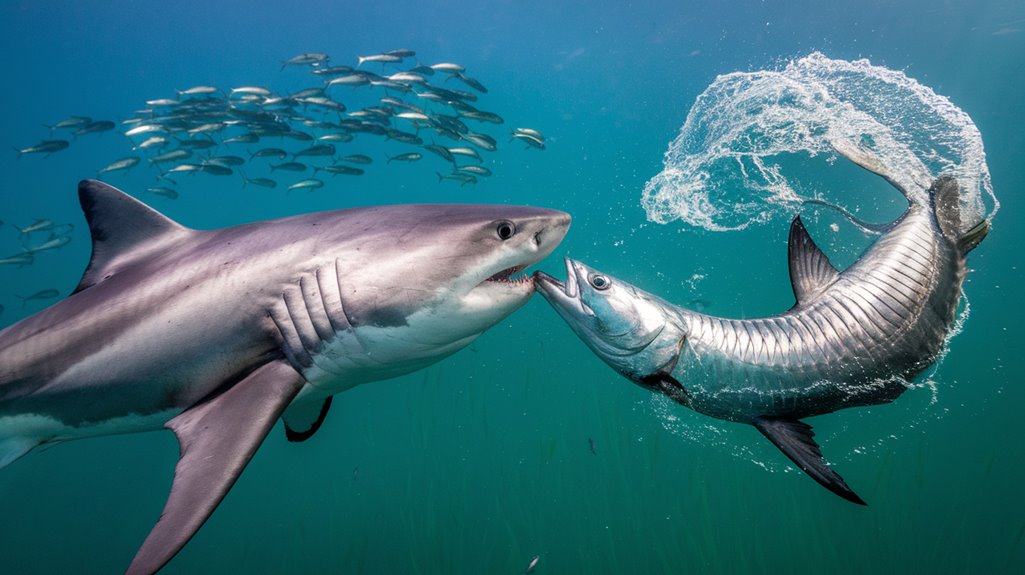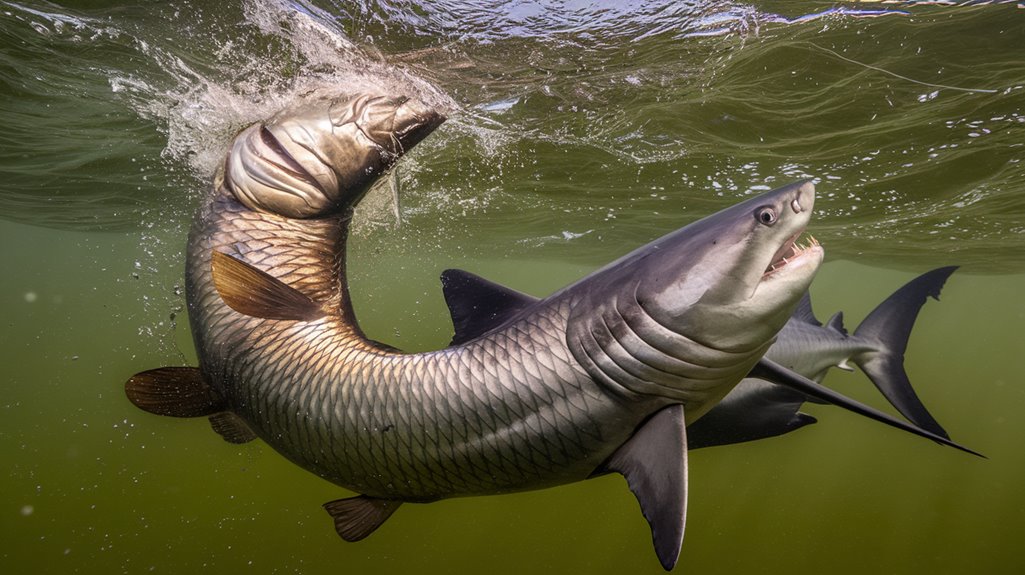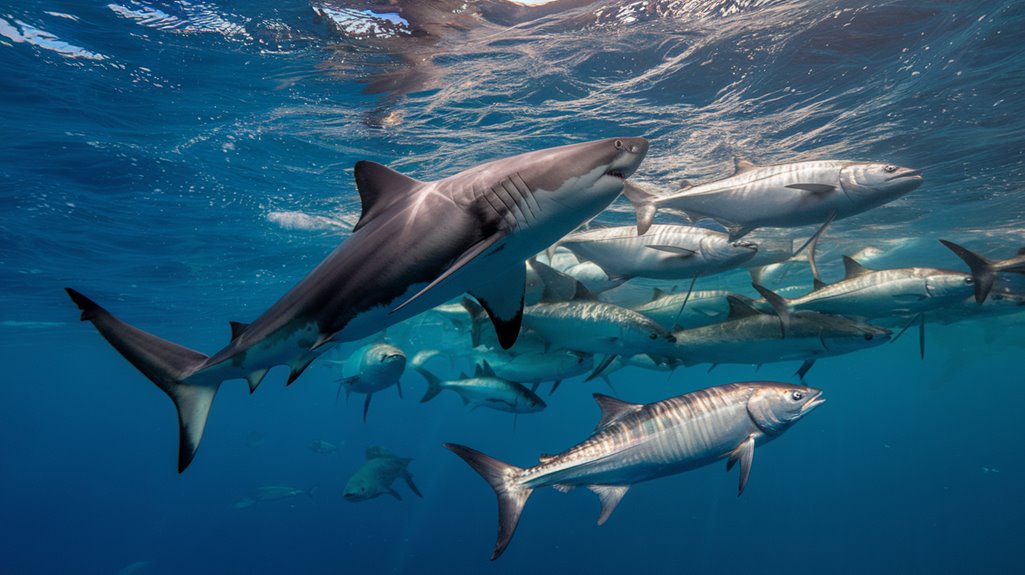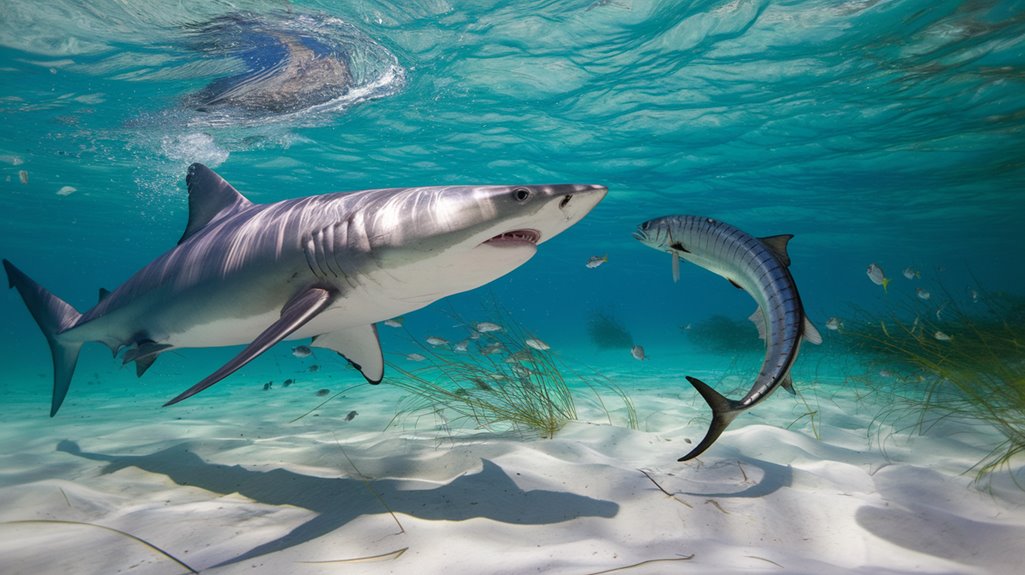You'll find the tarpon's place in the marine food chain tells a compelling story of survival and adaptation. As these silvery giants navigate coastal waters, they've developed remarkable strategies to evade their pursuers, from sharks to marine mammals. While adult tarpon can grow to impressive sizes, they aren't invincible to predation, especially in the Gulf of Mexico. Understanding who hunts them, and how they respond, reveals essential insights into marine ecosystem dynamics that continue to unfold.
- Key Takeaways
- Natural Predators of Adult Tarpon
- Juvenile Tarpon Vulnerability
- Defensive Adaptations and Survival Mechanisms
- Impact of Environmental Changes on Predation
- The Role of Sharks in Tarpon Population Control
- Predator-Prey Relationships in Estuarine Habitats
- Marine Mammal Interactions With Tarpon
- Seasonal Shifts in Predatory Pressure
- Frequently Asked Questions
- Conclusion
Key Takeaways
- Bull sharks and hammerhead sharks are primary predators of adult tarpon, especially during offshore spawning migration periods.
- Porpoises and alligators pose significant threats to tarpon in coastal areas, using coordinated hunting techniques.
- Predatory birds target juvenile tarpon in shallow waters, forcing young fish to seek shelter in mangroves.
- Adult tarpon have evolved protective features like thick scales and countershading to defend against predator attacks.
- Seasonal temperature changes influence predator-prey dynamics, with increased predatory pressure during warmer months above 79°F.
Natural Predators of Adult Tarpon

While tarpon are impressive fish known for their size and strength, they face several formidable predators in their marine environment. In the Gulf of Mexico and coastal waters, you'll find that bull sharks and hammerhead sharks are the primary hunters of large tarpon, actively pursuing these silvery giants during their seasonal movements.
You'll notice that adult tarpon are particularly vulnerable when they're migrating to offshore spawning grounds, where they'll encounter additional threats from porpoises and, in some cases, alligators near coastal areas. Despite their impressive swimming capabilities and size, tarpon rely mainly on their speed and agility to escape these predators. They've developed specific survival tactics, including their characteristic leaping behavior, which serves as an evasive maneuver when they're threatened by these formidable hunters.
Juvenile Tarpon Vulnerability
Juvenile tarpon's survival in shallow waters depends heavily on their ability to seek protection from predatory birds, which pose the greatest threat during their early life stages. You'll find these young fish selecting protected habitats such as mangrove roots, seagrass beds, and secluded backwaters where they can minimize exposure to aerial predators while feeding on plankton. These strategic habitat choices greatly increase their chances of reaching maturity, as they balance their need to feed with the constant risk of predation from above.
Shallow Water Survival Tactics
Despite offering crucial refuge from larger aquatic predators, shallow water environments present unique survival challenges for juvenile tarpon. You'll find these young fish employing sophisticated defensive strategies to combat threats from both above and below the water's surface. In shallow waters, they've developed a remarkable tactic called daisy chaining, where they form coordinated groups to enhance their collective security against predators.
As juvenile tarpon evolve from absorbing nutrients directly from seawater to becoming planktivorous feeders, they're particularly vulnerable to piscivorous birds swooping from above. To counter these threats, they'll seek shelter among mangrove roots and seagrass beds. While these habitats provide essential protection, they're also hunting grounds for smaller predatory fish, creating a complex balance between finding refuge and avoiding becoming prey.
Protected Habitat Selection
Selecting suitable nursery habitats proves essential for young tarpon's survival during their most vulnerable life stages. You'll find juvenile tarpon primarily inhabiting protected habitats within estuaries, mangroves, and shallow coastal waters, where they're shielded from larger predators like bull and hammerhead sharks.
During their larval development, these young fish face significant risks from smaller predatory fish and birds that target their eggs and early life stages. As they feed on zooplankton, they're particularly susceptible to predation in unprotected areas. You'll notice that juvenile tarpon maintain their presence in these nursery environments until they reach sexual maturity, at which point they'll shift to offshore waters for spawning. This strategic habitat selection demonstrates nature's essential role in supporting tarpon population survival through their most vulnerable periods.
Defensive Adaptations and Survival Mechanisms

Through millions of years of evolution, tarpon have developed remarkable defensive mechanisms that enable their survival against formidable predators. You'll find their thick, overlapping scales serve a dual purpose: they provide physical protection while reflecting light to disorient attacking predators. Their countershading adaptation, featuring dark dorsal surfaces and light ventral areas, helps them blend seamlessly into their aquatic environment.
When you examine their survival strategies, you'll notice their upturned mouth and large gape aren't just for feeding – these features allow them to quickly gulp surface air, maintaining oxygen levels during intense activity. Their distinctive rolling behavior at the surface isn't merely for oxygen intake; it's also a defensive maneuver that lets them rapidly change direction when evading threats like bull and hammerhead sharks.
Impact of Environmental Changes on Predation
As environmental conditions continue shifting globally, you'll observe significant changes in predator-prey dynamics affecting tarpon populations. You'll notice that warming ocean temperatures intensify predatory activity, particularly in tropical waters where consumption rates are higher. When you examine the ecosystem closely, you'll find that fluctuating oxygen levels affect the availability of food sources, disrupting established predation dynamics.
You'll discover that changes in salinity and water temperature directly influence how predators and tarpon interact within their habitat. These environmental shifts can create mismatches in traditional food web relationships, especially affecting vulnerable tarpon eggs and larvae. When you analyze the broader impact, you'll see that climate-induced disruptions to marine food chains create imbalances that threaten both juvenile and adult tarpon survival through altered predator-prey relationships.
The Role of Sharks in Tarpon Population Control

When examining the marine food web, you'll find that sharks serve as the primary apex predators controlling adult tarpon populations, with bull and hammerhead species being particularly important hunters. These predators strategically target weaker or injured tarpon, which helps maintain the overall health and genetic fitness of tarpon populations.
You'll notice that tarpon actively avoid areas with high shark density, as their survival instincts drive them to seek safer waters. This predator-prey relationship creates a delicate ecological balance that can be disrupted by human activities. When shark populations decline due to overfishing, it can lead to unexpected increases in tarpon numbers, potentially destabilizing the marine ecosystem. The mortality rate of adult tarpon considerably depends on shark predation, highlighting these apex predators' essential role in maintaining healthy marine communities.
Predator-Prey Relationships in Estuarine Habitats
Since estuarine ecosystems support diverse predator-prey dynamics, you'll find tarpon at different life stages facing varying levels of predation risk. These predator-prey relationships in estuarine habitats create a complex web where survival depends on adaptation and timing.
Vital elements of these relationships include:
- Larval tarpon absorbing nutrients and avoiding tiny predators like zooplankton
- Juvenile tarpon seeking shelter from piscivorous birds while feeding on small fish
- Adult tarpon evading larger predators such as bull and hammerhead sharks
You'll observe that estuarine habitats serve as protective nurseries where young tarpon can develop while minimizing predation risks. This delicate balance of predator-prey interactions underscores why maintaining healthy estuarine ecosystems is essential for tarpon population survival and growth.
Marine Mammal Interactions With Tarpon
You'll find that dolphins employ sophisticated hunting techniques when pursuing juvenile tarpon, using their echolocation abilities to track prey through turbid waters and coordinate group attacks. While manatees share coastal habitats with tarpon, these herbivorous marine mammals don't interact predatorily with them but often occupy the same seagrass beds and mangrove-lined shores. Although orcas aren't typically associated with tarpon predation due to limited habitat overlap in most regions, their occasional presence in subtropical waters can influence tarpon movement patterns and behavior.
Dolphin Hunting Strategies
Dolphins emerge as highly skilled predators of tarpon through their sophisticated hunting techniques and coordinated group efforts. Using their remarkable echolocation abilities, they efficiently track tarpon even in murky waters where visibility is limited. You'll observe these intelligent hunters employing strategic bubble nets and wave surfing to enhance their capture success rate.
Three key strategies make dolphins formidable tarpon predators:
- Coordinated group herding to concentrate tarpon schools into dense formations
- Creation of disorienting bubble barriers that limit escape routes
- Strategic timing of attacks during tarpon's vulnerable surface-rolling behavior
These hunting methods demonstrate dolphins' advanced problem-solving capabilities and their ability to exploit tarpon's biological needs, particularly when the fish must surface for oxygen. Their coordinated approach maximizes hunting efficiency while minimizing energy expenditure.
Manatee Habitat Overlap
While dolphins actively hunt tarpon in open waters, a different marine mammal relationship exists in coastal ecosystems. You'll find tarpon and manatees sharing the same tropical waters, particularly in Florida's shallow coastal regions and estuaries during warmer months. Though these species don't compete directly for food – manatees graze on aquatic plants while tarpon's gleaming scales flash as they pursue fish and crustaceans – they've adapted to coexist in these essential habitats. This overlap in their living spaces makes both species vulnerable to similar environmental pressures. When you examine their shared ecosystem, you'll notice how human activities, including boat traffic and habitat destruction, can disrupt the delicate balance of their cohabitation, affecting both species' survival patterns and behavioral dynamics.
Orca Predation Patterns
Although tarpon demonstrate impressive speed and agility in coastal waters, they aren't immune to predation by orcas, nature's apex hunters. You'll find that orca predation patterns on Atlantic tarpon reveal sophisticated hunting strategies, emphasizing the complex dynamics between these marine species. When orcas target tarpon, they employ coordinated tactics that showcase their remarkable intelligence and adaptability.
Consider these critical aspects of orca-tarpon interactions:
- Orcas use herding techniques to isolate tarpon from their schools
- Their hunting patterns often involve stunning prey through powerful tail slaps
- You'll observe that multiple orcas work together to exhaust and disorient tarpon before striking
While tarpon aren't the primary prey for orcas, these interactions considerably influence tarpon behavior and migration patterns, highlighting the intricate relationships within marine ecosystems.
Seasonal Shifts in Predatory Pressure
As water temperatures climb above 79°F, predatory pressure on tarpon intensifies due to increased activity from bull sharks and hammerhead sharks. You'll notice these seasonal shifts most prominently during the May-July spawning period, when tarpon migrate to offshore areas that overlap with shark feeding grounds.
During warmer months, you'll observe more frequent tarpon rolling behavior at the surface, which can attract predators and alter the dynamics of predation. The predatory pressure diminishes considerably in colder months, as shark activity decreases and tarpon become less visible in the water column. You'll find that these patterns are further influenced by seasonal variations in prey availability, particularly mullet and shrimp populations, as predators adjust their hunting strategies based on the most accessible food sources.
Frequently Asked Questions
What Are the Predators of the Tarpon?
You'll find that bull and hammerhead sharks prey on adult tarpon, while juvenile tarpon face threats from piscivorous birds. Early-stage tarpon are vulnerable to zooplankton, small fish, porpoises, and alligators.
What Does the Tarpon Eat?
You'll find that tarpon's diet changes with age: adults consume mullets and shrimp, juveniles feed on zooplankton and small fish, while larvae absorb nutrients from seawater before shifting to zooplankton.
Why Are Tarpons Endangered?
You'll find tarpons endangered due to overfishing, habitat loss of mangroves, commercial bycatch mortality, climate change impacts on water conditions, and declining prey populations that affect their survival rates.
Why Is Tarpon Fishing Illegal?
You'll find that tarpon fishing isn't entirely illegal, but it's heavily regulated in Florida to protect vulnerable populations. You need a special tag and must practice catch-and-release to guarantee species conservation.
Conclusion
You'll find that tarpon's predator-prey dynamics demonstrate complex ecological relationships, particularly in estuarine environments. The species' survival mechanisms have evolved to counter threats from sharks and avian predators, while environmental stressors continue to modify these interactions. By analyzing these relationships, you're able to better understand population control mechanisms and implement targeted conservation strategies that account for both predation patterns and habitat-specific challenges.

